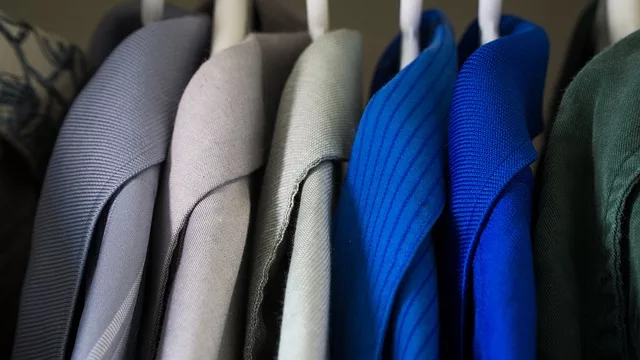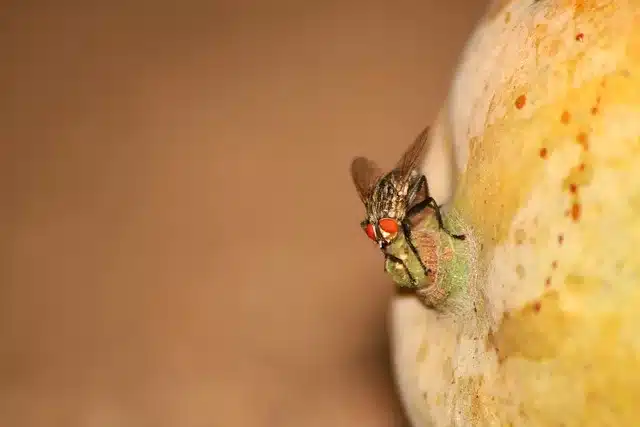You may encounter the elusive clothes moths, notably the Tineola bisselliella, commonly known as the common clothes moth, and its counterpart, the Tinea pellionella, the case-bearing clothes moth. These discreet pests excel at concealing themselves until havoc is wreaked upon your belongings. Are you willing to jeopardize the integrity of your wardrobe to these covert nuisances?
While moths may appear similar to some, it is imperative to distinguish these specific species that pose a threat to your natural fibres. Thriving in tranquil, undisturbed spaces, your cherished wool garments serve as their preferred sanctuary. Proficient in consuming keratin—a protein found in natural fabrics—these perpetrators ruthlessly target your attire, rugs, and upholstery.
Interested in identifying their larvae?
These pale caterpillars seamlessly blend with the textiles they consume, evading detection until irreversible damage is done. It is paramount to defend the sanctity of your abode. Are you prepared to intervene? Will you entrust the future of your treasured fabrics to these textile thieves, or will you take a stand to safeguard your environment? Rely on our expertise to eradicate clothes moths, enabling you to reclaim your residence through effective solutions.
The Life Cycle and Behaviour of Clothes Moths: Seasonal Pests in Irish Homes
Understanding the life cycle and behaviour of clothes moths is fundamental in developing a successful prevention strategy. These pests undergo a complete metamorphosis: from eggs to destructive larvae, then pupating into the less-damaging adult moths. The entire cycle can span from two months to two and a half years, contingent on environmental conditions.
With the advent of spring in Ireland, the temperature and humidity levels become more conducive to moth activity, accelerating their life cycle. The female moths lay clusters of tiny, white eggs hidden within natural fibres. These hatch into larvae, which are the main culprits for the damage as they voraciously consume the keratin in fabrics like wool, silk, and cashmere.
Warm and damp environments embolden the larvae, increasing their feeding activity and resulting in more extensive damage to your clothing and textiles. This is why spring, being a time of mild warmth and moisture, markedly sees an uptick in moth infestations. Vigilance during this season is crucial as catching an infestation in its nascent stage can thwart the cycle early and avert substantial damage.
Identifying Moth Damage: Signs of Infestations in the Home
Being vigilant about moth damage is essential for protecting your home. Telltale signs of an infestation include irregular holes in your clothing, especially in natural fibre garments such as wool, silk, or cashmere. You may also discover fine, web-like threads or tubes, which are the casings produced by the larvae.
In addition, look out for sand-like particles on your clothes or in the corners of your wardrobes and drawers; these are the larvae’s faecal pellets, indicating active feeding. If you detect a musty smell or come across clusters of small, creamy-white eggs on your fabrics, swift action is necessary to mitigate further ruin to your treasured items.
Prevention is the Best Cure: Safeguarding Your Home Against Moths
Preventing moth infestations is more manageable than trying to eradicate them once they have infiltrated your home. Here are some simple steps you can take to safeguard your belongings against these pests:
- Regularly vacuum carpets, rugs, and upholstery.
- Store off-season clothing in airtight containers.
- Launder or dry clean clothes before storing them away for long periods.
- Use cedarwood, lavender, or peppermint as natural moth repellents.
- Keep your home well-ventilated and dry to discourage the growth of larvae.
By following these preventative measures, you can avoid a potential infestation and save yourself from the headache of dealing with an established moth population.
Effective Solutions: How to Get Rid of Clothes Moths in Your Home
If you are already facing a clothes moth infestation, do not panic. There are effective solutions that can eradicate the pests and prevent further damage to your home.
Here are some options:
- Use pheromone traps to capture adult moths and prevent them from laying eggs.
- Apply insecticides or natural remedies to kill moth larvae and stop them from feeding on your fabrics.
- Seek professional help for severe infestations that require specialized treatment.
It is essential to take swift action when dealing with moths, as the longer you wait, the more damage they can cause. With these solutions, you can easily rid your home of these pests and protect your belongings. Remember to regularly monitor for any signs of re-infestation.
Natural Remedies and Solutions
Natural remedies and solutions for deterring and eliminating clothes moths can be both effective and environmentally friendly. Consider the following options:
- Cedar: Moths are repelled by the natural oils in cedar wood. Use cedar hangers for your wardrobes or place cedar blocks in drawers to keep moths at bay.
- Lavender: The scent of lavender is delightful to humans but detestable to moths. Place dried lavender sachets in your closets or drawers, or sprinkle lavender oil on fabric.
- Herbs: A mixture of dried rosemary, thyme, cloves, and bay leaves can act as a natural deterrent. Create sachets of these herbs to place among your stored clothing.
- Freezing: For items that you suspect are infested, placing them in a sealed bag and then in the freezer for at least 24 hours can kill moth larvae.
- Airtight containers: Storing clothing in airtight containers can prevent moths from laying eggs on them.
- Sunlight: Moth larvae dislike light and prefer darkness. Expose your textiles to sunlight regularly.
- Cleaning: Regular cleaning and dusting can disrupt the lifecycle of clothes moths, as can washing clothes in hot water and drying them in high heat, where appropriate.
By employing these methods, you can maintain the sanctity of your home textiles without the need for harsh chemicals.
Professional Moth Control Services
Sometimes, despite your best efforts with home remedies and preventative measures, a clothes moth infestation can become extensive and persistent. In such cases, it’s advisable to consider professional pest control services. These experts have access to more potent treatments and can implement integrated pest management strategies that are not typically available to the public. Professional services become necessary when:
- There is a recurring infestation, indicating a possibly larger unseen problem.
- Damage to clothing and textiles is significant and widespread.
- Moth sightings become frequent and you find larvae or eggs regularly despite thorough cleaning and use of traps.
- There are concerns about the safety and effectiveness of personally applied treatments, especially in homes with children, pets, or individuals with health sensitivities.
Trained technicians will not only help eradicate the existing moth population in your home but also provide guidance on long-term prevention to protect your treasured possessions from future attacks.
PestPros.ie: Expert Clothes Moth Eradication in Ireland
When it comes to safeguarding your Irish home from the persistent issue of clothes moths, PestPros.ie stands out as a premier service provider. With a deep understanding of the habits and life cycle of clothes moths, their experienced team offers comprehensive treatments tailored to the specific needs of your home. PestPros.ie employs a range of advanced strategies to ensure the complete removal of these pests, including:
- Detailed inspections to identify the extent and source of the infestation.
- Customized treatment plans that include the use of professional-grade insecticides and pheromone traps.
- Safe and sustainable options that are less harmful to the environment, pets, and inhabitants.
- Preventative advice and solutions to stop future infestations, backed by the knowledge of local Irish climatic conditions that can influence moth populations.
- Ongoing support and follow-up checks to guarantee the efficacy of their treatments.
By choosing PestPros.ie, you benefit from their commitment to customer satisfaction and their proven track record in restoring harmony to homes affected by clothes moths.
Conclusion: Summary of Combatting Clothes Moth Infestations
In conclusion, preventing and dealing with clothes moths involve a balance of caution and prompt intervention. To reiterate the key points:
- Prevention: It is always better to prevent infestations through the use of natural repellents such as cedarwood, lavender, and specific herb mixtures, as well as maintaining a clean and dry environment. Airtight containers and proper storage of off-season clothing can greatly reduce the risk of attracting moths.
- Detection and Immediate Action: At the first sign of moths, it’s crucial to use pheromone traps and to wash or freeze affected items, as this can stop the infestation from growing.
- Professional Help: For severe infestations, professional services such as those provided by PestPros.ie are recommended. Their expertise in handling pervasive problems can be invaluable, offering more powerful treatments and preventive strategies tailored to your specific situation.
By adhering to these practices and remaining vigilant, you can protect your belongings from the damage caused by clothes moths and ensure the longevity of your valued textiles.
Do not let clothes moths turn your treasured garments and textiles into their nesting grounds. Take decisive action today by reaching out to the experts at PestPros.ie. With a simple call or email, you can schedule a detailed inspection and receive a customised plan to eradicate these unwelcome guests from your home once and for all. Remember, peace of mind and the protection of your possessions is just one step away – contact PestPros.ie for your comprehensive moth control solution.
Royalty free Image supplied from PixaBay as part of SEO service from 3R.


